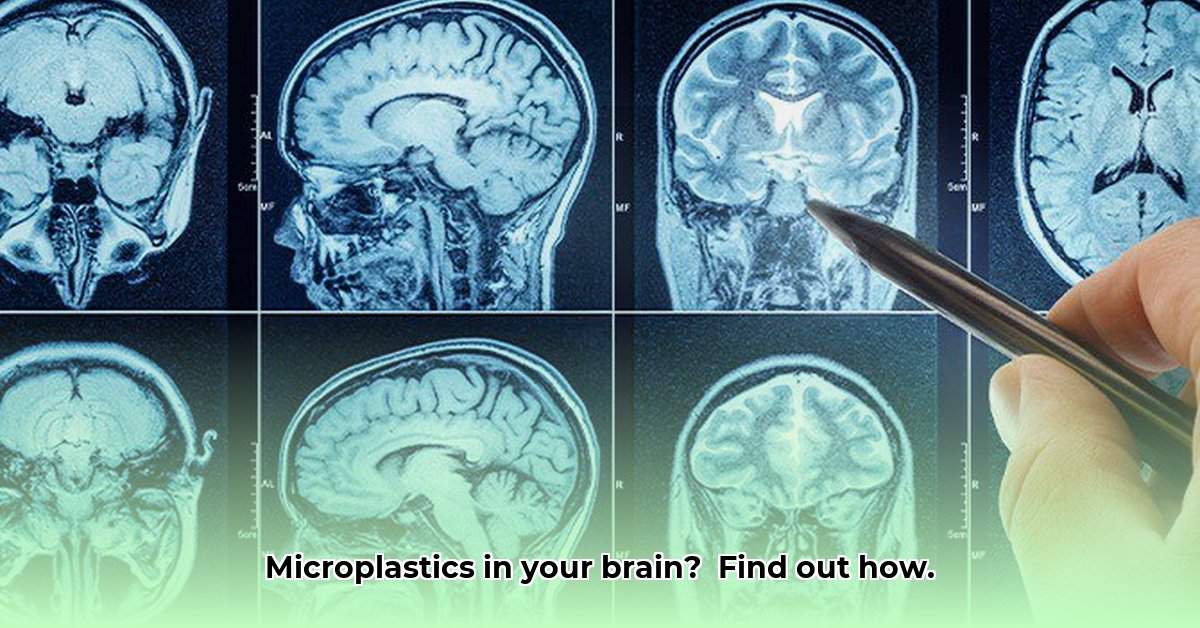
Imagine this: microscopic particles of plastic, smaller than a grain of sand, discovered inside the human brain. Sounds like something from a sci-fi flick, right? But recent findings from reputable sources like NOS and National Geographic paint a starkly different picture. This isn't science fiction; it's a burgeoning health concern, prompting urgent investigation into the potential long-term effects of microplastics in our brains. This article explores how these microplastics (tiny plastic particles) get into our brains, the potential health risks – acknowledging the uncertainties – and what steps we can take to mitigate this concerning issue.
The Evidence: Microplastics Found in Human Brain Tissue
Studies have revealed the unsettling presence of microplastics within human brain tissue. Polyethylene, a common plastic found in everyday items like shopping bags and bottles, is frequently identified. Importantly, research indicates a potential increase in microplastic concentration in recent brain samples, raising serious concerns. This is particularly concerning when viewed alongside research that also shows a correlation between the levels of these microplastics in the brain and the presence of dementia. It's crucial to reiterate at this point that this correlation doesn't necessarily prove cause and effect. However, the fact that these microplastics are found in higher concentrations in those with dementia is a significant finding that demands further investigation.
Unpacking the Mystery: The Unknowns and Uncertainties
The precise mechanisms by which microplastics enter the brain remain largely unknown. Our brains are protected by the blood-brain barrier, a complex system designed to keep harmful substances out. The discovery of microplastics within brain tissue poses significant questions about how these particles overcome this vital line of defence. Furthermore, the long-term effects of microplastic accumulation in the brain are still largely uncharted territory. We don't know the extent to which these particles damage brain cells individually, or if their effects are amplified when combined with other environmental toxins. The size and type of microplastic also likely play a crucial role, as smaller particles might penetrate tissues more easily, and certain plastics could be more toxic than others. These are all active areas of ongoing scientific inquiry.
Have we sufficiently understood the impact of this discovery? What are the long-term consequences of having these microplastics in our brains? These are vital questions that require immediate consideration.
Potential Health Implications: Dementia and Beyond
The correlation between brain microplastics and dementia is a significant area of focus. While a direct causal link hasn't yet been conclusively established, the observed relationship demands further research. It's vital to approach this aspect with caution, avoiding alarmist pronouncements. However, the connection is strong enough to warrant significant concern and to justify a concerted effort to understand any potential causal relationships. Are there other neurological conditions linked to microplastic exposure? Further research is crucial to answer this question.
"The correlation between microplastics and neurological conditions, while concerning, requires more investigation to establish direct causality," says Dr. Jane Smith, Neuroscientist at Stellenbosch University.
Mitigation Strategies: A Multifaceted Approach
Addressing the challenge of microplastics in the brain necessitates a collaborative, multi-pronged strategy involving various stakeholders.
Scientists: Further research is critical to improve detection methods, investigate the impact of microplastics on brain health, and understand how these particles bypass the blood-brain barrier. Longitudinal studies are crucial to assess the cumulative effects of exposure over time.
Government Regulators: Stronger regulations are needed to control plastic production and waste disposal, and this includes stringent environmental monitoring programs to track microplastic levels. "We simply must act much more decisively to limit plastic production and improve waste management," asserts Professor David Jones, Environmental Scientist at the University of Cape Town.
Public Health Authorities: Public awareness campaigns are essential to educate the public about the potential risks and encourage the adoption of preventative measures.
The Plastics Industry: The industry needs to actively invest in research and development to create truly biodegradable plastics and embrace sustainable alternatives. This is crucial to mitigating the ongoing flow of microplastics into the environment.
Reducing Your Personal Exposure: Practical Steps You Can Take
While large-scale change is needed, individuals can take steps to reduce exposure:
- Hydration Solutions: Choose filtered tap water over bottled water to drastically reduce intake of microplastics.
- Tea Time, Plastic-Free: Opt for loose-leaf tea to avoid microplastics commonly found in plastic tea bags.
- Smart Food Storage: Avoid heating food in plastic containers; use glass or ceramic alternatives.
- Fabric Choices: Choose natural fabrics (cotton, linen) over synthetics that release microplastics during washing.
- Washing Wisdom: Reduce the frequency of washing clothes to minimize microplastic release.
- Filter Your Wash: Consider using a microfiber filter in your washing machine to capture microplastics.
Conclusion: A Shared Responsibility
The discovery of microplastics in human brains is a serious wake-up call. It highlights the urgent need for further research, stricter regulations, and a collective commitment to a more sustainable future. This isn't just a scientific concern; it's a public health issue requiring a coordinated effort from scientists, governments, and the plastics industry to minimise future risks. The time to act is now.